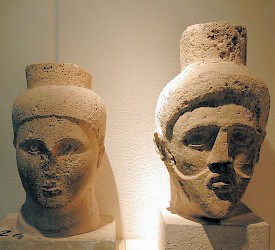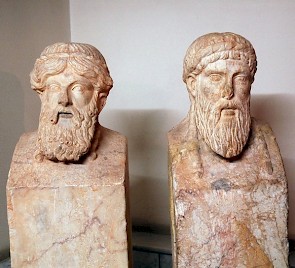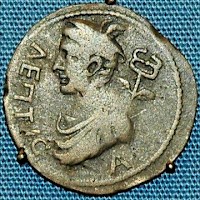Lepcis Magna: Punic City
Q191504Lepcis Magna: Phoenician colony, later part of the Carthaginian empire, the kingdom of Massinissa, and the Roman empire. Its most famous son was the emperor Septimius Severus (r.193-211).
Origin

The Romans added the three cities of Tripolitana - Lepcis, Oea, and Sabratha - to their empire when they annexed Numidia, the kingdom of Jugurtha, towards the end of the second century BCE. Two generations later, the Roman historian Sallust, who wrote a History of the War against Jugurtha, stated that Lepcis had been founded by Sidonians, who had left their home town because of civil discord.note This statement is not unproblematic. When ancient authors describe migrations, they nearly always mention civil disorder as its cause; and the topical nature of Sallust's statement makes us hesitate whether we must believe him. Things are not made easier by the fact that the Roman author Pliny the Elder, writing more than a century after Sallust, mentions Tyre as Lepcis' mother town.note

However, it is certain that the first settlers of Lepcis arrived directly from Phoenicia, and were not sent out from Carthage - something that might have been possible as well. Had they been Carthaginians, they would have venerated Ba'al Hammon and Tanit; the main cults in Lepcis, however, were Melk'ashtart and Shadrapa, who were later identified with Hercules and Dionysus. Among the other gods were Reshep (Apollo)note and Eshmun (Asclepius).note Their temples have not yet been identified.

The native tribes - the Macae are mentioned by the Greek researcher Herodotus of Halicarnassusnote - must already have occupied the site before the Phoenicians arrived and built their own settlement. Had it been otherwise, the town would have had a Phoenician name, but Lepcis, Lpqy, is Libyan. (The same applies to Sbrt'n and Wy't, Sabratha and Oea.) It comes as no surprise that the inhabitants of Tripolitana are in the ancient sources often called Libyphoenicians. The two ethnic groups were not on equal footing, though; no Libyan sanctuaries are known and Sallust states that the Lepticine laws were Phoenician.
Soundings in the area of Lepcis' Old Forum have brought to light some remains of this earliest phase, but because the Roman forum is on top of it, excavation will be difficult. A ritual cemetery (tophet) was identified, and it was established that the Lepcitanians did not sacrifice their children to Baal Hammon, as other Phoenicians did; the children were replaced by small animals. It is certain that on the site of the theater there was a Libyphoenician cemetery, where people were sometimes buried with Late Corinthian and Italo-Corinthian ceramics and local imitiations. But again: excavation will be difficult. If we want to know more about the origins of Lepcis, we can only make some guesses.
It is reasonable to assume that Lepcis was a trading post, founded to facilitate trade with the tribes of the Fezzan, from which ivory, gold, and other products of Subsaharan Africa could be obtained. The mountain zone beyond Lepcis allows the culture of olives, and it is likely that oil was among Lepcis' earliest export products. Along the wadis, wheat could be produced.
Carthaginian hegemony
At some stage, the area became Carthaginian. It is possible that this happened in response to a request from the three Libyphoenician cities, who needed protection against Greek settlers. From the late seventh century, they were living in Cyrenaica, and in 515/514, a Spartan prince named Dorieus tried to build a town near the Wadi Qaam. A Carthaginian intervention put an end to the Greek colonial enterprise.note This incident is the terminus ante quem for the annexation of Tripolitana by Carthage.
Hardly anything is known about the next three centuries, although it is likely that Lepcis, like so many other Phoenician towns in the west, abandoned the kingship and preferred a constitution with two supreme magistrates (the suffetes), a Council, and an Assembly. The ceramic evidence from the cemetery suggests an increase of imports from Attica in the fifth century. The story of the Philaeninote may also belong to the next century. Libyans are also mentioned among the Carthaginian troops in the First Punic War (264-241), during Hannibal's invasion of Italy (218), and during the fights in Spain during the Second Punic War. It is likely that Lepcitanians were among them, but the details are unclear. There is only one glimpse of information: according to the Roman historian Livy, Lepcis paid the enormeous amount of one talent of silver per day to its Carthaginian overlords,note By that time, the city issued its own coinage, showing Melk'shtart and Shadrapa.
In the first third of the second century, the Roman Senate allowed the Numidian king Massinissa to destabilize the Carthaginian dominions. He repeatedly tried to capture the three cities of Tripolitana,note and was ultimately successful in 162/161. Some ten years later, the Third Punic War broke out and the Romans sacked Carthage in 146. Because Rome was at the same time interested in expansion to Iberia, Greece, and Asia, the Numidian dynasty could expand its influence even more.
Roman occupation
After 112, however, king Jugurtha had become too powerful, and the Senate sent troops, which established Roman order in Africa. At the beginning of this war, Lepcis allied itself to Rome, and it loyally supported Rome's proconsul Lucius Calpurnius Bestia, and the consuls Spurius Postumus Albinus and Quintus Caecilius Metellus.
The last-mentioned sent four cohorts of Ligurians to defend the town when a local potentate named Hamilcar tried to usurp power.note Lepcis was now a Roman garrison town. It was soon incorporated in the Italian economic system: in his Verrine Speeches, Cicero mentions a banker named Titus Herennius, who was active in Lepcis.note
Literature
- A.R. Birley, Septimius Severus. The African Emperor (1999³ London)
- Oriana Dal Bosco & Maria Teresa Grassi, Libia mediterranea e romana (20054; Firenze)
- Antonino Di Vita e.a., La Libye antique. Cités perdues de l'empire romain (1998 Paris)
- K.D. Matthews, Cities in the Sand (1957 Philadelphia)